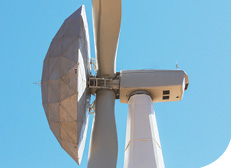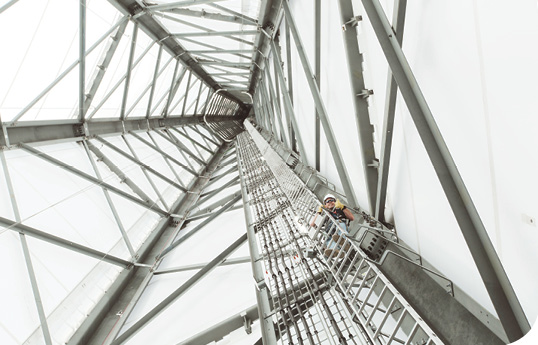
If experiments confirm wind-tunnel data, the 20,000-pound dome could lead to larger and more efficient turbines.
Some have likened it to a UFO stuck atop a utility tower and others simply call it “big nose.” Granted, it’s not your usual wind turbine but GE, the engineers behind a unique new design, are more concerned about efficiency than aesthetics. The design started out with a styrofoam ball and a toothpick when GE scientists were challenged to build a rotor that could harvest more wind.
The result is a lone prototype that today rises some 137-plus meters (450-plus ft.) from base to blade tips, and stands out amongst a sea of conventional turbines in California’s Mojave Desert. It’s called the ecoROTR for Energy Capture Optimizer by Revolutionary Onboard Turbine Reshape. GE started testing the 20,000-pound domed ecoROTR in May of this year as part of the company’s ecomagination initiative, which aims to build cheaper machines with a lower environmental impact.
ecoROTR was designed with the intent of addressing two significant wind-turbine issues: efficiency and size. The dome’s operating theory goes like this: Wind hitting near the center of rotor is basically lost, or according to GE “wasted.” The team of GE scientists figured if they could deflect the wasted wind from the hub, the aerodynamic sections of blade could still harvest its power. The engineered “nose” or aluminum dome can also mount on larger rotors without further adjustments.

This GE engineer is heading up the ecoROTR’s 97-m space-frame tower, which is also a prototype. It holds one of GE’s most powerful machines, the 1.7-MW wind turbine, and the attached 18.3-m experimental dome.
Data from a wind tunnel test showed the potential for a 3% improvement in performance. This might not seem like much but GE maintains that improvement multiplies across an entire wind farm, enough so that they took a model turbine to the University of Stuttgart in Germany for more testing. This led to the desert prototype, a 18.3-m (60-ft.) experimental dome attached to the 100-m diameter rotor on a 1.7-MW GE wind turbine. Even the tower is a prototype.
Instead of traditional rolled steel sections, the 97-m (318-ft.) latticework or space-frame tower is wrapped in a polyester-weave coat. Before it is constructed, tower girders or support beams easily load into shipping containers and onto ordinary trucks. According to GE, the steel beams more easily bolt together in places that were previously hard to reach during tower construction.
It will take until the fall of this year before data is fully collected from the ecoROTR’s prototype. Until then, we’ll have to wait and see if a UFO-like aluminum dome could serve as the future model for wind turbines.
For a digital copy of the entire August issue of Windpower Engineering & Development, click here.
Filed Under: News, Projects, Turbines





Still with this… This technology is based on a 2008 patent from GE. The technology was analyzed at the time and it was determined that there would be an AEP benefit, although not 3% , but no LCOE benefit. This is because material costs with the additional head mass of the dome itself combined with structural reinforcements for the hub as well as alteration of the spinner negate most of the performance benefit. Rotor induction is not altered by this, only the channeling of flow from the less productive central portion of the rotor to the outboard sections. This alters the angle of incidence of the oncoming wind which will make it necessary to alter optimal pitch angle as well. Changing optimal pitch at rated will also reduce AEP from the rotor slightly, but the hope is that the increased flow on the outboard section (also slightly accelerated by the dome) will compensate. This technology in combination with a tailored blade that has an optimal pitch angle to work with the dome might provide more of a benefit, but applying this as some sort of “upgrade” to existing turbines is unlikely to provide the gains advertised. The design changes and tooling changes to the blade will also make this costly to implement. Not a winner, but it seems like innovation.
Thanks for your comments Mr. Eschavaria:
I think GE is to be applauded for building a prototype and putting it on one of its own turbines for testing. Three percent is a significant AEP figure, but as you suggest, there may be more cost effective ways to improve AEP that much. Fixing yaw error might be one, and as you suggest, the better blade will always be the one in the CFD modeler. Most turbines are good distance from the 59% (?) Betz limit so let progress continue.